
Estimated reading time :
April 18, 2025 6:22 am
Amethyst vs other purple stones : How to tell the difference (A Comprehensive Guide) ✅
Writer’s Name :
Date of Publishing :
Writer’s Name :
Arya
Estimated reading time :
Introduction
If you thought Amethyst is the only stone that wears a purple robe and sits proudly on the pedestal of épique luxury, I might have to break that bubble for you & you’ll thank me later.
Purple gemstones have captivated humanity for centuries with their regal hues and mystical allure. From the well-known amethyst to the rare purple sapphire, these stones offer a diverse palette of violet shades that cater to various tastes and budgets all while adding that extra sprinkle of charm to your wardrobe as well as your life.
In this article, let’s discuss 13 stunning purple gemstones, each with their unique characteristics. But before that, have a look at this image showing all of them at once-
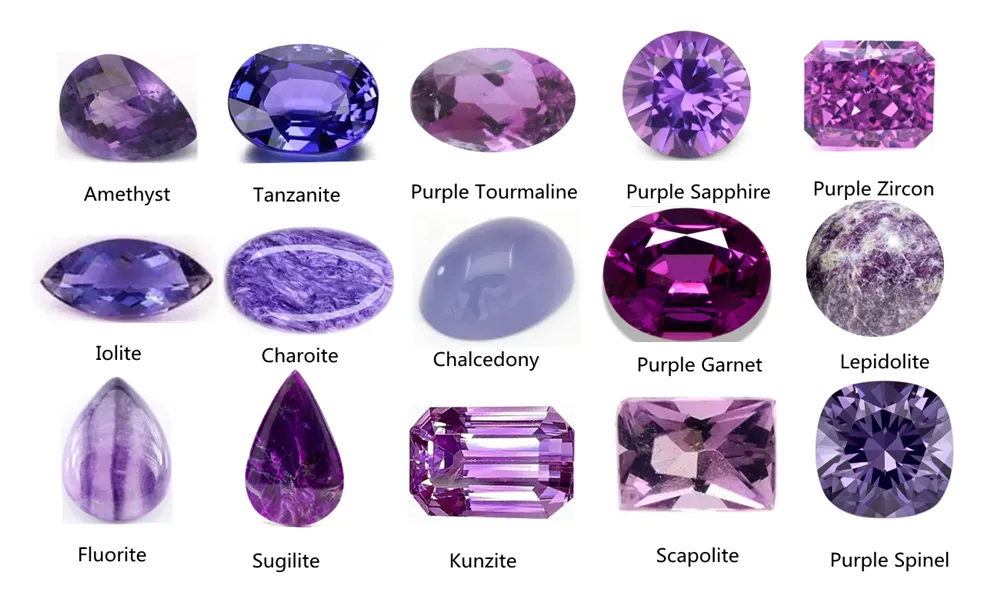
1. Amethyst: The Classic Purple Beauty
Well, it’s obvious I had to talk about this beauty first. Amethyst, the February birthstone, is perhaps the most famous purple gemstone. This variety of quartz ranges from pale lilac to deep reddish-purple. With a hardness of 7 on the Mohs scale, amethyst is durable enough for everyday wear.
Once considered as precious as rubies and sapphires, to the point that commoners weren’t allowed (the audacity of elites duhh) to wear it; amethyst became more accessible after large deposits were discovered in Brazil in the mid-1900s.
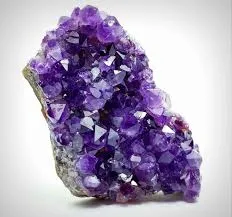
Ancient Greeks believed amethyst could prevent intoxication, leading to the creation of drinking vessels made from this stone.
Some amethysts can be heat-treated to produce citrine or prasiolite (green quartz). Check out this blog to understand whether your amethyst is real or not.
In case you are curious to read more about this gorgeous beauty, I have this article for you that talks everything about Amethyst in detail.
2. Purple Sapphire: The Regal Rarity
Sapphires, sapphires, sapphires…If there could be a song lyric I could dedicate to this epitome of luxury on behalf of our entire human race, it’d be – “Trippin’ fallin’ with no safety net” cuz this one’s got all of us swoon about it.
Sapphire itself comes in multiple shades of blue ranging from the deep royal blues to the pale sky blues. But did you know that there’s purple sapphires too, commonly known as Khooni Neelam, that are pretty rare & it’s rarity is what makes it a valuable gemstone. With a hardness of 9 on the Mohs scale, it’s second only to diamond in durability.
If elegance, sophistication, creativity, wisdom and spiritual growth could have been packed in 1 single stone, it’s this purple sapphire.
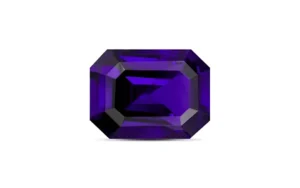
Purple sapphires can display hues from bluish-purple to reddish-purple.
In Vedic astrology, purple sapphire is associated with Saturn and is believed to offer protection from negative energies.
We cover more about sapphires and their types in this article – Gemstone 101 : Sapphire
3. Tanzanite: The Trichroic Wonder
Discovered in 1967 near Mount Kilimanjaro, tanzanite is a relatively new addition to the gemstone world. This variety of zoisite is known for its striking blue-violet color and pleochroic properties, showing different colors when viewed from different angles.
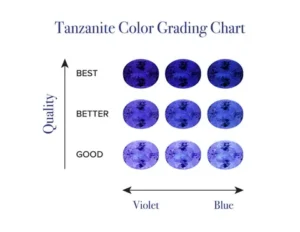
Tanzanite is considered 1000 times rarer than diamonds.
It’s believed to aid in spiritual awakening and enhance intuition.
Curious to explore more about Tanzanite? I’ve got you covered 😉 Here you go! – Gemstone 101 : Tanzanite
4. Purple Tourmaline: The Versatile Gem
As a stone available in brown, red, orange, yellow, green, blue, violet, pink, or hues in-between to even being colorless, tourmaline is probably the rainbow we all need in our life.
Though, generally you’ll find it in the shades of green and red.
Purple tourmaline on that note, part of the diverse tourmaline family, offers a range of purple hues from soft lavender to deep grape. With a hardness of 7 to 7.5, it’s suitable for various jewelry applications.
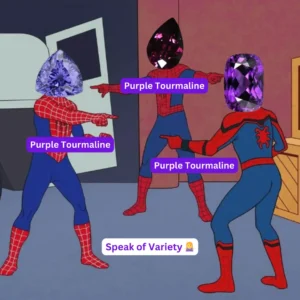
Some purple tourmalines display a cat’s eye effect, adding to their allure.
Read more about Tourmaline & it’s rainbow personality in this article here.
5. Purple Zircon: The Diamond Doppelgänger
Purple zircon is a rare and dazzling gemstone that often masquerades as diamond due to its exceptional brilliance and fire. Its vibrant hues range from soft lavender to deep violet, courtesy of trace elements (it’s actually a silicate mineral) or heat treatment.
With a Mohs hardness of 6 to 7.5, purple zircon is suitable for most jewelry types, though it requires some care to prevent scratches.
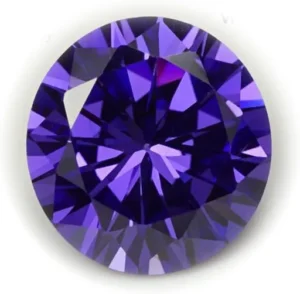
Its high refractive index and double refraction give purple zircon a distinctive sparkle that sets it apart from other purple gemstones so if your eyes judge things before your soul does, this one will pass the vibe check.
Thinking of getting zircon instead of a diamond but need more reasons? I got you! Check out this article that talks about everything zircon.
6. Purple Garnet: The Underrated Beauty
Garnet, the January birthstone, although now available in a palette of multiple colors (due to group formation of closely related minerals), always has been adored for it’s red color for it carries it’s own history.
However, did you know that there’s a purple garnet existing on this planet, that goes by the name – “rhodolite” and typically exhibits a mix of red and purple hues. It’s a variety of pyrope-almandine garnet with excellent brilliance and fire.
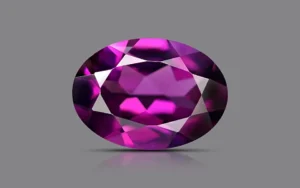
Purple garnets were first found in Madagascar in the late 1990s.
Jan-birthed humans would love to read this one- Gemstone 101 : Garnet
7. Purple Spinel: The Brilliant Impersonator
Made up of magnesium and aluminum, spinel alongside tourmaline boasts a range of multiple colors, purple being one of them.
Long mistaken for other gemstones (including some famous “rubies” in crown jewels), purple spinel is finally getting its due recognition. It offers exceptional brilliance and a hardness of 8, making it suitable for everyday wear.
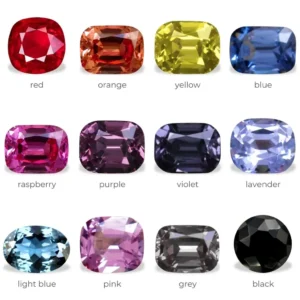
Purple spinel is believed to promote calmness, creativity, and spiritual growth.
Spinel be making you want to check it out? Here you go!
8. Lavender Jade: The Soothing Stone
Lavender jade, a light purple variety of jadeite, a gentle shade of purple that’s not too dark or saturated, is highly prized in Asian cultures. It’s believed to purify energy and prevent negative thoughts and emotions, bringing it close to an amethyst (and it’s use in the Buddhist culture).
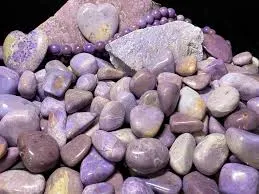
Lavender jade gets its color from titanium content. Learn more about the ultimate meditation gemstone jade here.
9. Purple Topaz: The Chameleon Gem
Topaz, along with Citrine is a November birthstone, majorly known for its orange, yellow and blue colors. However, nature also has blessed us with a purple topaz. It has a hardness of 8, making it quite durable for jewelry use.
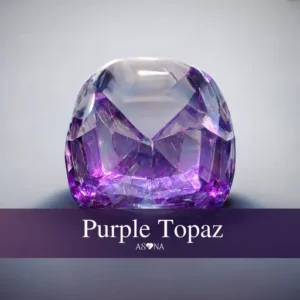
The purple hue in topaz is often attributed to chromium content. November humans, this article on Topaz was written specially for you.
10. Purple Spodumene (Kunzite): The Pastel Beauty
Typically known for its pink varieties, spodumene also occurs in light purple hue. It’s known for its strong pleochroism and delicate pastel colors.
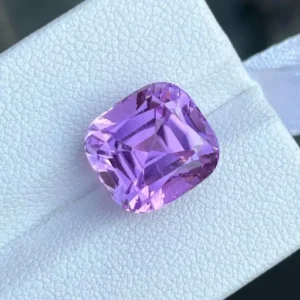
Kunzite can fade with prolonged exposure to sunlight, so it’s best worn in evening jewelry. Read more about Kunzite here.
11. Purple Scapolite: The Fluorescent Gem
Also known an marialite, similar in appearance to amethyst but softer, purple scapolite is known for its distinctive fluorescent properties. Purple scapolite in it’s crystal form, is an extremely rare gem. It’s more of a collector’s stone due to its relative softness.
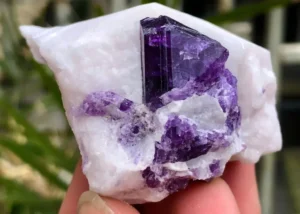
Under UV light, purple scapolite can exhibit a striking orange fluorescence. We cover more about Scapolite in this article.
12. Sugilite: The Opaque Oddity
Sugilite is a rare, pink to purple cyclosilicate mineral. It has an opaque to translucent clarity with a deep purple color, often with black matrix patterns. It’s typically cut into cabochons or beads due to its opacity.
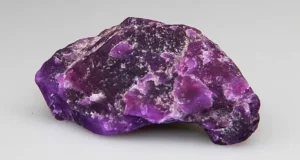
Sometimes called “manganese gem” due to its high manganese content. Read more about Sugilite here.
13. Charoite: The Swirling Purple
Charoite is a rare semi-precious silicate mineral known for its vibrant purple color with swirling patterns. It’s only found in one location in Siberia, Russia, adding to its rarity and appeal.
It is also known as the lilac stone and has a glass-like appearance.
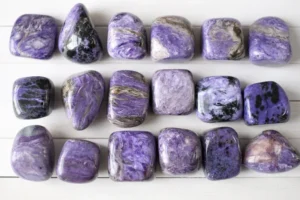
The unique swirling patterns in charoite make each piece one-of-a-kind. Wanting to get your hands on one this swirly beauty? Check this article before that.
14. Purple Fluorite: The Rainbow Maker
Purple fluorite is sister to amethyst when it comes to the spiritual aspect. This peace-giving gemstone is devoted to the part of the mind that connects with spirits, helping in keep the mind clean and increase mental eagerness.
While softer than many gemstones, purple fluorite is prized by collectors for its beautiful color and interesting crystal formations. It’s known for its fluorescence under UV light.
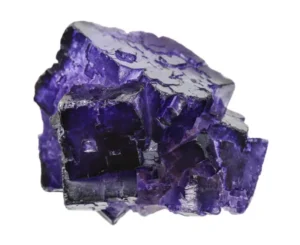
Fluorite has a low refractive index, giving it a glassy appearance. Fluorites will make you swoon over itself and we are here to support the cause with this article.
15. Lepidolite: The Stress-Busting Beauty
Lepidolite, a lithium-rich mica mineral, offers a soft, lavender to lilac-purple hue that’s as soothing to the eye as it is to the mind. This stone is known for its calming properties and is often used in meditation practices.
With a Mohs hardness of 2.5 to 3, lepidolite is quite soft, making it more suitable for pendants and earrings rather than rings.
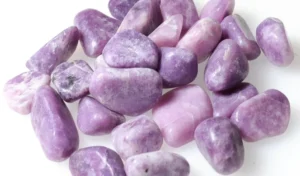
Lepidolite is believed to be a powerful stress reducer and mood stabilizer, promoting emotional balance and inner peace.
Its flaky, pearlescent appearance gives lepidolite a distinct shimmer, setting it apart from other purple stones. Check out this article on Lepidolite to learn more about what makes this semi-precious stone special.
16. Iolite: The Viking's Compass
Iolite, also known as water sapphire or cordierite, is a gemstone that displays a beautiful violet-blue color. Its name comes from the Greek word “ios,” meaning violet.
Iolite is strongly pleochroic, appearing violet-blue from one angle and nearly colorless from another. This property made it useful to Viking navigators as a polarizing filter.
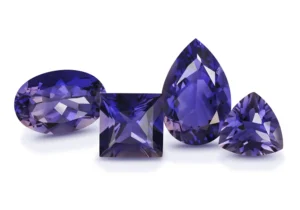
With a Mohs hardness of 7 to 7.5, iolite is durable enough for most jewelry applications.
Despite its nickname “water sapphire,” iolite is much more affordable than true sapphires, making it a popular alternative in jewelry.
Sapphire or Iolite? Want to know which one’s for you? We’ve made it easy for you, check this out.
17. Chalcedony: The Pastel Dream
While chalcedony comes in many colors, its purple variety, often called “holley blue agate,” offers a soft, pastel purple that’s both elegant and understated.
Purple chalcedony is a microcrystalline quartz, formed from solutions rich in silica. With a Mohs hardness of 6.5 to 7, purple chalcedony is suitable for all types of jewelry.
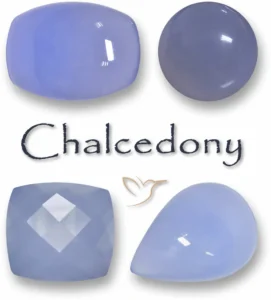
Purple chalcedony is associated with creativity, imagination, and dream recall. It’s often used to promote restful sleep and vivid dreams.
Its translucent to opaque appearance gives purple chalcedony a soft, dreamy quality that distinguishes it from more transparent purple gems. Check out this article on Chalcedony.
If you’ve made it this far, welcome to the purple stone suitors gang!
From the classic beauty of amethyst to the rare allure of purple sapphire, these 17 purple gemstones offer a fascinating journey through the violet spectrum of the mineral world. Whether you’re drawn to their metaphysical properties, their historical significance, or simply their stunning beauty, there’s a purple gemstone to suit every taste and purpose. #there_is_a_purple_for_everyone
You may also like


